Babette Hughes's Blog, page 2
April 29, 2013
My Country 'Tis of Thee
When I was in first grade Miss Charlton (whom we called Charlie because of her mustache) marched us into the auditorium to learn “My Country ‘Tis of Thee.” She sat down at the piano and led us through the song word by word, playing the piano with one hand and directing us with the other. When we came to the phrase “Land where my father died,” I couldn't figure out how they all knew. At home my father’s death was this big secret. There wasn't even a photograph of him anywhere, as if a picture could suddenly whisper the truth. Since all the other kids had fathers I reasoned it must be my father who died on the land they were singing about. He vanished without a trace of the ordinary clutter and details of a life, leaving not a shadow nor footprint. There were no letters or insurance papers or tax receipts to find. Not a watch or drivers’ license or birth certificate or deed to a house. No marriage license or diploma. No fading photograph that he had carried, maybe of me. Not a wedding portrait or snapshot at the beach. It was as if during the 29 years of his life on earth he was already a ghost.
 I was two years old when my bootlegging father-- and innocent uncle who just happened to be in the wrong place at the wrong time-- were murdered, and don’t remember him. But my older brother, Kenny, told me of his charm, violent temper and generosity. I found two pictures of him among my mother’s possessions after she died. In one, my father is a dark-eyed child on a tricycle. The other shows a muscular youth standing with his brother, Marvin, in front of a horse and delivery wagon from the family bakery. The picture is slightly out of focus, his grin blurred, but you can see his physical strength and his readiness to use it. In the other he stands serenely in a handsome tan suit looking for all the world like a gentleman of banking or the law. His lips are thick and sensual, his brown eyes deep set. He is a beautiful young man frozen in his youth by death, silence and myth. He is a stranger and a daddy who didn't love us enough to stay alive.
I was two years old when my bootlegging father-- and innocent uncle who just happened to be in the wrong place at the wrong time-- were murdered, and don’t remember him. But my older brother, Kenny, told me of his charm, violent temper and generosity. I found two pictures of him among my mother’s possessions after she died. In one, my father is a dark-eyed child on a tricycle. The other shows a muscular youth standing with his brother, Marvin, in front of a horse and delivery wagon from the family bakery. The picture is slightly out of focus, his grin blurred, but you can see his physical strength and his readiness to use it. In the other he stands serenely in a handsome tan suit looking for all the world like a gentleman of banking or the law. His lips are thick and sensual, his brown eyes deep set. He is a beautiful young man frozen in his youth by death, silence and myth. He is a stranger and a daddy who didn't love us enough to stay alive.

Published on April 29, 2013 19:14
April 22, 2013
Reluctant Model
After my mother pulled me out of 12thgrade, we made the rounds of department stores and shops and photographers. To my surprise, I was hired by Halle’s to model in the tearoom at lunchtime; by Higbee’s and May’s for their fashion shows; photographer Harry Cole for his fashion shoots and catalogues and Quinn-Maas, an expensive specialty shop. I strutted on runways, stretched my legs and pointed my toes for the photographer, and in fashion’s convoluted calendar, posed in fur coats and rivers of sweat in July and bathing suits and goosebumps in January. I demonstrated vacuum cleaners at conventions, sprayed cologne at ladies in department stores, paced runways in my new hip-swinging stride, all the while feeling an immense sorrow. I had become my mother’s creation, her idea of me, a no-brainer not even fit to finish high school, a moving, speaking walking size 8, her windup girl-toy, an early pioneering Barbie, pushed down the road of her vicarious fantasies. With no idea of who I was or wanted to be, I went along, riveted by her will as she sat in the dark corner of the photographer’s studio, the front row of the style shows, the table in the tearoom.
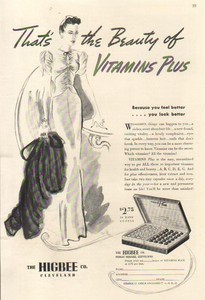 Backstage I changed outfits in 50 seconds. Or rather the two dressers did, one of them stripping the clothes off my back while the other pulled the next change over my head. They grabbed the shoes from my feet, thrusting my toes into another pair (you hold onto the dresser’s back for balance) hung my neck with jewelry, patted down my hair and there I was, out on the runway again. 50 seconds flat. If it was a swimsuit show you were stripped naked but no one looked at you, not even the male buyers and merchandisers who were milling around backstage. They’d watch the audience through a part in the curtain or appraise the clothes hanging on racks, or ask someone why numbers 26, 14 and 43 weren't in the show.
Backstage I changed outfits in 50 seconds. Or rather the two dressers did, one of them stripping the clothes off my back while the other pulled the next change over my head. They grabbed the shoes from my feet, thrusting my toes into another pair (you hold onto the dresser’s back for balance) hung my neck with jewelry, patted down my hair and there I was, out on the runway again. 50 seconds flat. If it was a swimsuit show you were stripped naked but no one looked at you, not even the male buyers and merchandisers who were milling around backstage. They’d watch the audience through a part in the curtain or appraise the clothes hanging on racks, or ask someone why numbers 26, 14 and 43 weren't in the show.Every day from twelve until two I modeled in Halle’s tearoom. In the dressing room, staring at my reflection at the stranger in the mirror with the breasts and shimmering silver gown and silver sandals, I seemed to have emerged overnight willed into being by my mother.
Read more of Lost & Found by author and model, Babette Rosen HughesOR read her novel, The Hat, a story of a bootlegger's wife.Sequel, The Red Scarf, to be release in July 2013
Published on April 22, 2013 16:15
April 11, 2013
Gun Molls
Special Prosecutor Thomas Deweyrelied heavily on the testimony of gun molls of the 1930’s. When arrested and interrogated, the women had to choose between jail or cooperating with the prosecutors. If they choose cooperating they were given no protection and were either murdered by their ex-lovers or forced into hiding for the rest of their lives. Meanwhile, she was a worker bee. Performing the housework of crime, gun molls packed the loot and ammunition—sometimes in the frantic moments of a police shootout-- purchased cars, rented apartments to be used as hideouts, opened safe deposit boxes for the loot, and acted as go-between between gang members scattered by the police.
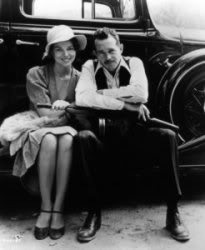 Billie Frechette, John Dillinger’s lover, cooked, cleaned and ran his errands. She was born Evelyn “Billie” Frechette in 1907 in Neopit, Wisconsin to a French father and a Native American mother. She lived on the Menominee Reservation and attended school there until the age of 13 when she moved to a government boarding school for Native Americans.
Billie Frechette, John Dillinger’s lover, cooked, cleaned and ran his errands. She was born Evelyn “Billie” Frechette in 1907 in Neopit, Wisconsin to a French father and a Native American mother. She lived on the Menominee Reservation and attended school there until the age of 13 when she moved to a government boarding school for Native Americans.When she was 26, in 1933, after struggling to make ends meet cleaning and waitressing, she met the 30-year old John Dillinger at a dance hall in Chicago, and fell in love. Unlike Bonnie Parker she never participated in Dillinger’s crimes but was arrested anyway by the Department of Investigation Special Agents on April 9, 1934 for harboring a criminal. Dillinger drove around the block several times after her arrest unable to rescue her. She served 2 years. Tipped off to the FBI by a girlfriend, Dillinger was shot down on July 22, 1934, as he left a movie theater in Chicago. Bonnie Parker, gun moll to Clyde Barrow, was born Oct. 1, 1910. She was the middle child and oldest daughter of Henry and Emma Parker. An honor student and poet she worked as a waitress at Marco’s café where she became friends with Ted Hinton (who would ironically take part in gunning her down.) She met Clyde Barrow in 1930. When he was arrested, she smuggled a gun into the prison, helping him escape. Then, two years after he was arrested again and released, she joined him on a crime spree of robbery and murder until gunned down by the police on May 23, 1934, in Bienville Parish, Louisiana..
Published on April 11, 2013 07:32
March 25, 2013
Bugsy Siegel
“My friends call me Ben, strangers call me Mr. Siegel, and guys I don’t like call me Bugsy, but not to my face.”
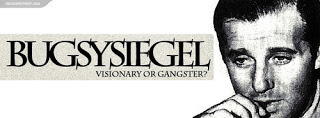
Still the name Bugsy stuck—even if it was behind his back. It’s unknown whether the media—who loved writing about the violent and dangerous-- or his cohorts-- gave him the name. But whether he liked it or not, it was his during his lifetime and beyond.
He was born Benjamin Hymen Siegelbaum on February 28, 1906. Although he was a contemporary of my bootlegging father, he lived to the ripe old age of 41 while my dad was murdered in a turf war with the mafia when he was 29.
Siegel was known as the father of Las Vegas because of his early establishment of the Flamingo Hotel & Casino in the desert. He was the son of immigrants as were other Jewish bootleggers of the time, like Morris Kleinman, Abe Landau, Moe Dalitz and my father, Louis Rosen. Raised in the crime- ridden section of Williamsburg, Siegel met Meyer Lansky with whom he built an empire of bootlegging, gambling and murder, known as Murder, Inc. They became lifelong friends--that is, until Lansky ordered his friend’s assassination in 1947 for skimming mob money from the Flamingo Hotel.
With an eye out for getting into the movies (Siegel was very handsome) he moved his operations to the West Coast. Maintaining an extravagant lifestyle in Beverly Hills he bought a palatial estate and established friendships with Hollywood moguls and movie stars, as well as a relationship with the infamous Virginia Hill.
He was murdered in the house rented by her at 810 Linden Drive, Beverly Hills. She was out of town at the time--there are those who say it was highly recommended to her that she “leave town for her health.” He was buried in a $5000.00 casket in the Beth Olam section of Hollywood Forever Cemetery. Only five family members showed up for the service which took place before the cemetery opened. Among his possessions were a billfold with $408 in cash, a watch, a money clip, a key chain with 6 keys (one being for a hotel room) a ring and a pair of cufflinks. Here is a great documentary about Bugsy! And for you Boardwalk Empire Fans...
Next: Gun Molls
Published on March 25, 2013 10:23
March 18, 2013
Meyer Lansky
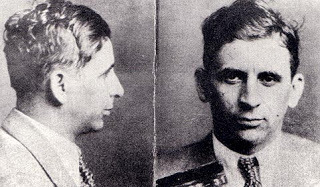 Whoever said that crime doesn’t pay didn’t know about Meyer Lansky, the Jewish bootlegger, gambler and all around criminal, who, in 1970, was worth $300,000,000. He hid his money in a Swiss numbered bank account, whose anonymity was assured by the 1934 Swiss Banking Act.
Whoever said that crime doesn’t pay didn’t know about Meyer Lansky, the Jewish bootlegger, gambler and all around criminal, who, in 1970, was worth $300,000,000. He hid his money in a Swiss numbered bank account, whose anonymity was assured by the 1934 Swiss Banking Act.Unlike most criminals, Lansky reached the ripe old age of 81, while my bootlegging father, who was Lansky’s contemporary, was killed at 29 -- and whatever money was left to my mother was lost in the Great Depression.
Lansky was born Meyer Suchowljansky in Russia to a Jewish family who, he claimed experienced vicious anti-Semitic pograms. In 1911 he immigrated to the US with his mother and brother. He met Bugsy Siegel on the Lower East Side when they were teenagers. They became lifelong friends—Bugsy saved Lansky’s life more than once -- and became partners in the bootlegging trade along with Lucky Luciano. Lansky was instrumental in Luciano’s rise to power by organizing the 1931 murder of Mafia powerhouse Salvatore Maranzano. (Get ready for that story, Boardwalk Empire fans!)
By 1936 he had developed a gambling empire that stretched from Saratoga, New York, to Miami, to Council Bluffs, Iowa, and Las Vegas. He was into narcotics, pornography, prostitution, labour racketeering and extortion and also got control of legitimate hotels, golf courses and a meat-packing plant
He organized mob funding for Bugsy Siegel’s Flamingo Hotel and Casino in Las Vegas. But when he kept its losing money, Lansky ordered his friend’s execution.
Like Arnold Rothstein and Bugsy Siegle, he captured the imagination of authors, television producers and moviemakers. The character Hyman Roth in The Godfather Part 11 was based on Lansky. Max Bercovicz, the gangster played by James Woods in Once Upon A Time In America was inspired by Meyer Lansky, as well as in Havana,staring Robert Redford. Dustin Hoffman played Lansky in The Lost City
Does that say something about our culture’s values?
Lansky died of lung cancer on January 15, 1983, after spending a quiet respectable life in Miami. He was buried there in an Orthodox Jewish ceremony.
He left behind a widow and three children.
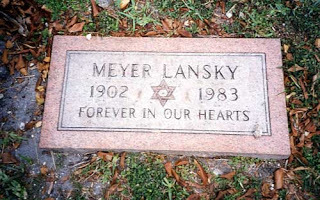
Interview with Meyer Lansky, 1971
Next: Bugsy Siegel
Published on March 18, 2013 07:32
February 25, 2013
Arnold Rothstein
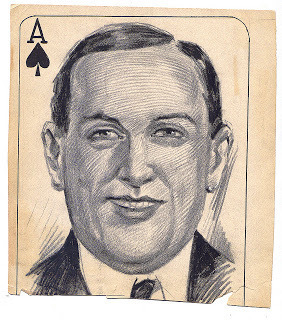 When I was two years old, my bootlegging father, Louis Rosen, was murdered along with my innocent uncle in a turf war with the Mafia. They were ambushed and shot in our driveway as they arrived home from a card game at Taback’s Cigar Store. Although the killer got away, it was well known not only who he was but that he would never be identified. The impact on my family and on my life-- amid the drama of Prohibition and the Great Depression-- has animated my memoir and novels.
When I was two years old, my bootlegging father, Louis Rosen, was murdered along with my innocent uncle in a turf war with the Mafia. They were ambushed and shot in our driveway as they arrived home from a card game at Taback’s Cigar Store. Although the killer got away, it was well known not only who he was but that he would never be identified. The impact on my family and on my life-- amid the drama of Prohibition and the Great Depression-- has animated my memoir and novels. My father was among a Whose Who of Jewish bootleggers, whose histories are varied, interesting and complicated. For example. Arnold Rothstein’s background made him an unlikely “kingpin of the Jewish underworld.” His brother became a rabbi and his father, who served as chairman of the board of New York’s Beth Israel Hospital, was a pious and wealthy businessman known for philanthropy and honesty,
In Rothstein’s late 20’s he opened a gambling parlor; by 1912, when he was thirty, he was a millionaire. He captured the imagination of his time-- Damon Runyan modeled the character Nathan Detroit in “Guys and Dolls” after Rothstein. And in “The Great Gatsby,” F. Scott Fitzgerald created a Rothstein-based character, named Meyer Wolfsheim.
In 1919 Rothstein arranged, through an intermediary, to pay the Chicago White Soxplayers $80,000 on the condition that they lose to Cincinnati. They did, and Rothstein made a fortune betting against Chicago. In 1921 eight players, led by first- baseman Chick Gandill, were convicted of trying to fix the Series. Rothman, who never met the players and could say that he never approved the intermediary’s scheme, was acquitted.
He was murdered by a fellow gambler in 1928 at the age of 46 without revealing his assailant’s name. Because of his father, he received an Orthodox Jewish funeral with the renowned rabbi, Leo Jung.
Next: Meyer Lansky
Published on February 25, 2013 19:37
February 19, 2013
Downton Abbey, Season 3 Finale
 According to an interview with Julian Fellowes, creator and writer of Downton Abbey, the theme of the series is about people confronting change whether they like it or not. The show started in 1912, just before the Great War, but in the 1920’s there was an accelerated rate of change. It was actually the end of the Second World War that was the coup de grace for Crawley type people.
According to an interview with Julian Fellowes, creator and writer of Downton Abbey, the theme of the series is about people confronting change whether they like it or not. The show started in 1912, just before the Great War, but in the 1920’s there was an accelerated rate of change. It was actually the end of the Second World War that was the coup de grace for Crawley type people. Jessica Brown Findlay who played Lady Sybil, and Dan Stevens who played Mathew Crawley wanted to leave after season three, so they had to be killed off—Sybil in childbirth and Mathew in a car crash.
The back story about Robert and Cora is how she came to England as an American heiress and met Robert who married her for her money and then fell in love.
The ending of season 3 has left enough loose ends for season 4 and beyond. Mary, now a young widow, is poised for new love and maybe a comeuppance for her snobbery. Thomas’ revelation that he is gay is another interesting story line. The introduction of “difficult” Rose, who has left her mean mother and moved in with the Crawleys, provides more potential drama. And what about Lady Edith on the threshold of finding love and becoming (gasp!) a mistress! But all the characters in Downton Abbey are so richly drawn in their humanity, that as I write, I am in withdrawal.
Published on February 19, 2013 08:44
February 12, 2013
Season Three, Episode Six
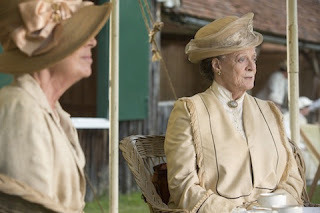
Watching Downton Abbey last night I was reminded of wisdom given in writing workshop I attended namely, that without conflict there is no story. Which may be one of the reasons we’re riveted each and every week.
For example: conflicts between physicians leading to Sybil’s death…between Mathew and Robert about running the estate…….between compassion and bias regarding an ex-prostitute trying to change her life…..between guilt and forgiveness of Sybil’s parents…between the generations as Robert Crowley and Mr. Carson cling stubbornly to changing times……between religions……between names for the baby.
There has to be good news, too. Mr. Bates’ final release from prison. A new baby girl. The promise of Daisy’s release from service into a new and promising future.
Have you ever seen such gorgeous mourning clothes? And those magnificent hats!
When did ladies stop wearing hats?
Published on February 12, 2013 06:57
January 28, 2013
DOWNTON ABBEY: SEASON THREE, EPISODE FOUR
A birth and a death. A former prostitute. Kitchen and estate conflicts. The continuing saga of Mr. Bates’ murder conviction. The old guard represented by Grandmamma; the new by Mathew’s mother, Mrs. Crowley. These themes and more were all layered deliciously in the fourth segment of Downton Abbey. But two doctors arguing vehemently and loudly about life and death treatment for a woman in labor? In front of the family yet? Please. Now I know Downton Abbey is a fairy tale! But what a fairy tale. And how interesting and surprising as each doctor proves to be right-- and then wrong-- about their diagnosis of Lady Sybil, leading to her death. The baby survives, as everyone upstairs and downstairs in Downton Abbey mourns Lady Sybil— no doubt among millions of viewers all over the world. Meanwhile there is a conflict about running the estate—with more foreshadowed to come—between young Mathew, whose money saved Downton Abbey, and Lord Crowley, the head honcho-- also illustrating the generational conflict between the status-quo and moderninity. Here’s what I especially like about Downtown Abbey: * It’s gentleness amidst all the violence in television and movies-- and in life. *The classically trained actors. *The depiction of a unique time and place that is gone forever, never to return. *It’s awareness of the changes in society and the world. *The beauty of the production. * The pleasure of living vicariously with dozens of servants (cooks, drivers, footmen. Ladies maids! Valets! Who dress you!) *I love stories and this is a good one!
Published on January 28, 2013 14:12
January 14, 2013
Downtown Abbey: Season 3, Episode 2
Confronted by a letter Lavinia sent from her deathbed endowing her wealth to Mathew, he finally relented and used his inheritance to save Downton Abbey. (Surprise surprise)
After keeping us—and the Abbey staff --in suspense about whether Mrs. Hughes is sick we learn with relief before the hour is up that she doesn’t have cancer.
Anna, in her search for information that can prove her husband’s innocence and obtain his release from a lifetime in prison, learns that the woman he is convicted of killing was afraid of him! Could our nice Mr. Bates really be a murderer? If so, I think it could put some interesting teeth into the story.
And poor Lady Edith! As if being outshone by her prettier sisters for her entire life wasn’t enough of a humiliation, she is jilted publicly by the groom as she stands at the alter in her wedding gown. Only a total jerk would do something that horrible to a woman so maybe she is well rid of him.
My favorite character in Downton Abbey is Mathew’s mother, Mrs. Crawley. Unlike her fellow aristocrats she believes that the privileged have responsibilities to the less fortunate. In this episode she is helping prostitutes and reaching out to a particular young woman who, viewers of previous episodes will recognize as having been formerly involved with the Crawley family.
When someone is the family wonders how to help Lady Edith, who is so devastated she can’t eat or sleep, Mrs. Crawly, always a voice of reason, replies, “Get her some work to do!”
I love the hats...
After keeping us—and the Abbey staff --in suspense about whether Mrs. Hughes is sick we learn with relief before the hour is up that she doesn’t have cancer.
Anna, in her search for information that can prove her husband’s innocence and obtain his release from a lifetime in prison, learns that the woman he is convicted of killing was afraid of him! Could our nice Mr. Bates really be a murderer? If so, I think it could put some interesting teeth into the story.
And poor Lady Edith! As if being outshone by her prettier sisters for her entire life wasn’t enough of a humiliation, she is jilted publicly by the groom as she stands at the alter in her wedding gown. Only a total jerk would do something that horrible to a woman so maybe she is well rid of him.
My favorite character in Downton Abbey is Mathew’s mother, Mrs. Crawley. Unlike her fellow aristocrats she believes that the privileged have responsibilities to the less fortunate. In this episode she is helping prostitutes and reaching out to a particular young woman who, viewers of previous episodes will recognize as having been formerly involved with the Crawley family.
When someone is the family wonders how to help Lady Edith, who is so devastated she can’t eat or sleep, Mrs. Crawly, always a voice of reason, replies, “Get her some work to do!”
I love the hats...
Published on January 14, 2013 09:49



